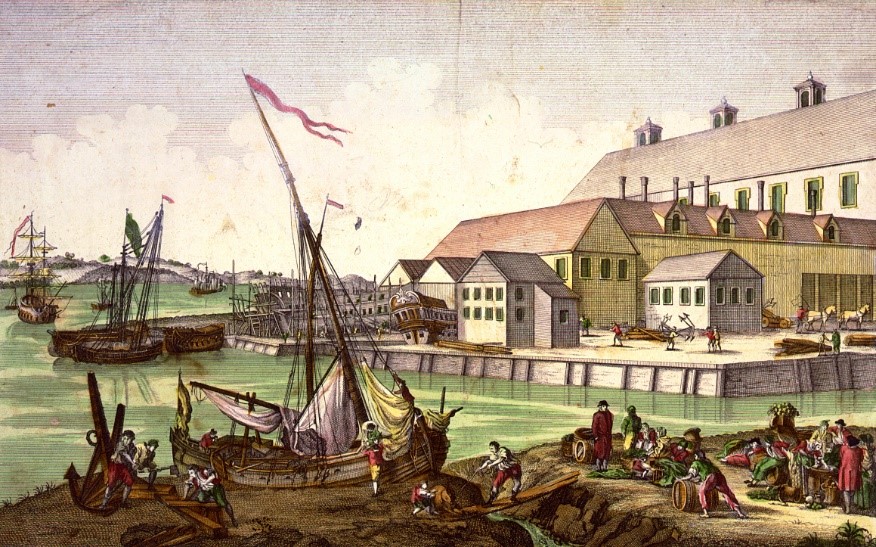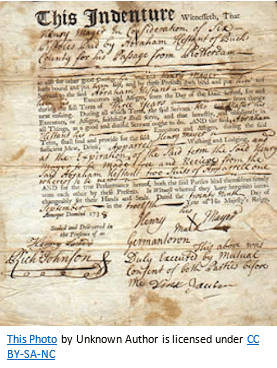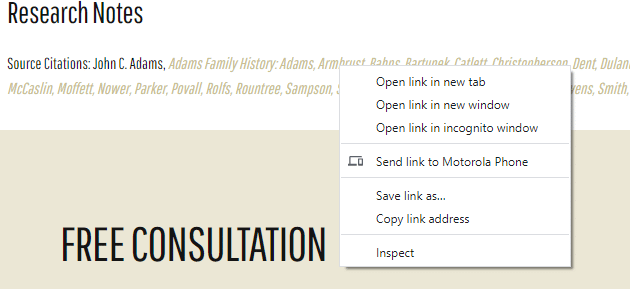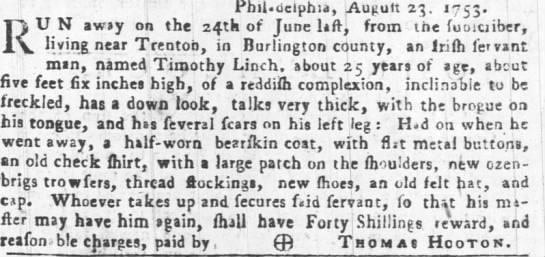The Immigrant Servants Database
 15
15Oct
 Colonial America was a land of opportunity, offering possibilities and freedoms that most impoverished Europeans could only dream of. With a voyage across the Atlantic, these dreams could become realities. The problem was that those most wanting this opportunity couldn’t afford passage across the Atlantic. Indentured servitude presented an opportunity for poor people to get to America to start new lives.
Colonial America was a land of opportunity, offering possibilities and freedoms that most impoverished Europeans could only dream of. With a voyage across the Atlantic, these dreams could become realities. The problem was that those most wanting this opportunity couldn’t afford passage across the Atlantic. Indentured servitude presented an opportunity for poor people to get to America to start new lives.
Large numbers of early Americans came as indentured servants, redemptioners, or convicts, and many Americans today descend from these people. Price Genealogy’s Immigrant Servants Database is an indexed compilation of records of indentured servants, convicts, and redemptioners, who began their American adventures in servitude. This article will review the history of indentured servants in the British colonies, how to use the database, and a case study of an immigrant whose information was found in this database.
Immigrants History
Indentured servants sold themselves into servitude to pay for passage to America. They would offer themselves to merchants or ship captains, who would sail them across the Atlantic Ocean and sell them to people in America needing laborers. Oftentimes, the merchant or captain would receive land from the crown based on how many people they brought to the colonies. The person who bought an indentured servant became their owner or master for the term of the indenture—usually four to five years. During that time, the indentured servant was valued as property.
Redemptioners paid part of their passage before departure and would attempt to pay the rest shortly after arrival. If they failed to pay, they were sold as indentured servants to pay off the rest of their passage. Redemptioners often came with their families and supplies for life in America.
Convicts did not come voluntarily as they were sent to America in servitude as a punishment for their crimes. Convicts’ terms were usually longer than those of indentured servants and redemptioners.
This went on through much of the 17th and 18th centuries, and into the 19th century. Indentured servitude declined in the 18th century as importation of slaves increased.
Because owners of indentured servants wanted as much labor as possible for their money, they worked their servants very hard. However, the masters had to be careful not to work their servants too hard, because they could die from exhaustion or might decide to run away. Runaways are fascinating to research as you will see below.
At the end of the indenture’s term, the servant was freed from servitude and would receive his (or her) “freedom dues,” which differed in each colony and changed over time. In some colonies, the freed servant would receive clothes, money or tools. Some colonies provided land, which the freed indentured servant often sold. A freed indentured servant was allowed to start a life of his (or her) own, and the freedom dues given them were things that would help with that.
Challenges to Researching Indentured Servants
 Like immigration or emigration research generally, researching indentured servants and their families may involve research in both the U.S. and the home country in Europe. American sources identifying indentured servants include church registers, court records, deeds, servant contracts, journals and other personal narratives, land patents, merchant account books, newspapers, passenger lists, and probate records. Available English sources include church registers, indentured servant contracts, manor records, parish chests, probate records, surname sources, tax lists, and urban occupational records.
Like immigration or emigration research generally, researching indentured servants and their families may involve research in both the U.S. and the home country in Europe. American sources identifying indentured servants include church registers, court records, deeds, servant contracts, journals and other personal narratives, land patents, merchant account books, newspapers, passenger lists, and probate records. Available English sources include church registers, indentured servant contracts, manor records, parish chests, probate records, surname sources, tax lists, and urban occupational records.
When an emigrant sold himself into servitude, indenture papers were created. In England, these were copied by clerks in ports who compiled them into registers. Not many of these papers survive in the U.S. because freed indentured servants had no motive to keep their indenture papers.
During the term of indenture, servants created very few records. Once freed, the records they created may not mention previous status. This makes it difficult to identify an indentured servant in the U.S.
Another challenge with researching indentured servants is they rarely traveled with family or neighbors. This means that FAN (family, associates, neighbors) club methods of research often will not work.
Because indentured servants were valued as property, they could be mentioned in deeds or wills. Sometimes an owner of an indentured servant sold the servant (the remainder of the indenture) to another. If the owner died before the indenture ended, the servant might be bequeathed to the owner’s heir. If there’s no other evidence that one was an indentured servant, this is a give-away because paid servants wouldn’t be valued as property.
Church records in the U.S. may include burial records for servants who died during their indenture. Marriage records are rare because indentured servants couldn’t marry without permission from their master. Because of this, indentured servants who bore children often had them illegitimately. So, births of children to indentured servants are more likely to be found in court records for misdeeds than in church records. Such records may include cases of indentured servants assaulting their master and cases of indentured servants being caught after trying to run away.
On the European side, almshouse or parish poor law records may be a good place to find your indentured servant ancestor, because they came from poor families. Additionally, church records would show the births of indentured servants and maybe marriages for the indentured servants who abandoned their spouses.
Another possible challenge with researching indentured servants is possible discrepancies with recorded birth places. Some records required the last place of residence rather than the birthplace. When a birthplace was given, the immigrant may have listed the nearest big town to their village. Therefore, research may need to be conducted in a broad area.
How to Use the Immigrant Servants Database:
If you have an ancestor who was an indentured servant, the Immigrant Servants Database will likely be a good place to find information about them. Like any database, this database has a basic search engine, and an advanced search engine. The third way to search is to click on a letter of the alphabet and browse by surname.
Once you get to an ancestor’s page, you will see an abstract of information, listing at minimum the name, date, and place of indenture. Some entries include family information such as parents and spouse, birth information, arrival information including the ship, information about the master, etc. The information varies from entry to entry.
The most important information in any entry is the citation. This is where the information in our database came from, and there is often more information at the source than in our database. Some of the citations have links, which can make it easier to find the information being cited. However, some of the links are broken. If the link isn’t broken, it may take you to a digital copy of the book or to another database and it may be necessary to locate the specific page or search the additional database. In either case, it is recommended to open the citation link in a new tab.

If there is no link in the citation, or the link is broken, there are multiple ways to look for the information. The easiest method would be to highlight the citation, right click it, and select the option to search Google for the highlighted text. This most often leads to links to buy the book; sometimes it leads to a digital copy of the book.

It may be more practical to borrow the book than to buy it, especially if the book is expensive. To see if a library near you has the book, search for the title in Worldcat. To see if the Family History Library has a copy of the book, search for the title in the FamilySearch Catalog.
To look for a digital copy of the book, search in Google Books or in FamilySearch Books.
A Case Study
The database entry for Timothy Linch states he was born in 1728 in Ireland, that he was an indentured servant in 1753 near Trenton, Burlington, New Jersey, and that his master’s name was Thomas Hooton. This is not very much information to base research on, and it’s rather dull. Following the citation led to far more interesting information about Timothy. More information can be extracted from the record cited than the database entry, and the record gives better research clues.
The record cited led to a notice about a runaway, as seen below.[i]

The best thing an indentured servant could do for his distant posterity was to run away from his master, because the genealogically information contained in the runaway ad is so valuable. The physical description of Timothy Linch would be fun for his posterity to have, especially if any of them share those features.
Timothy Linch ran away about two months before the advertisement was posted in Philadelphia. It is unlikely that Thomas Hooton waited two months to advertise concerning his missing servant. According to Google Maps, Trenton (New Jersey) and Philadelphia (Pennsylvania) are an eleven-hour walk to go from one to the other. Riding a horse or in a carriage in the eighteenth century would certainly have taken several hours. Posting an ad in a big city this far away would not have been convenient for Thomas, but a bigger newspaper would have reached a larger audience. After being away for two months, it is likely that Timothy could have gone far, thus necessitating the need for a broader audience the see Thomas’s advertisement.
It is also important to note that the advertisement stated that Thomas lived near Trenton, rather than in Trenton. This suggests that he had a farm, and that Timothy may have worked on this farm. Timothy apparently was not happy with the treatment and work conditions that he was subjected to.
There is no indication in the clipping of how long Timothy had been in Thomas’s service, nor how much longer he had to go. The statement that Timothy “talks very thick, with the brogue on his tongue” suggests that he had not been in the colony long enough to have lost his heavy Irish brogue.
If you need help researching your indentured servant ancestor, the experienced genealogy researchers at Price Genealogy can help.
By Katie
Painting in public domain via Wikimedia Commons
Indenture certificate: The original uploader was Greensburger at English Wikipedia., Public domain, via Wikimedia Commons
[i] Thomas Hooton, “Run Away,” The Philadelphia Gazette, 6 September 1753, p. 3, col. 3; digital images, Newspapers.com (https://newspapers.com : accessed 11 October 2021).
